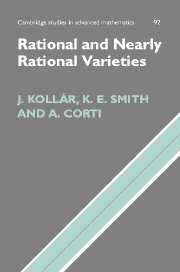Introduction
Published online by Cambridge University Press: 25 May 2010
Summary
The most basic algebraic varieties are the projective spaces, and rational varieties are their closest relatives. Rational varieties are those that are birationally equivalent to projective space. In many applications where algebraic varieties appear in mathematics, we see rational ones emerging as the most interesting examples. This happens in such diverse fields as the study of Lie groups and their representations, in the theory of Diophantine equations, and in computer–aided geometric design.
This book provides an introduction to the fascinating topic of rational, and “nearly rational,” varieties. The subject has two very different aspects, and we treat them both. On the one hand, the internal geometry of rational and nearly rational varieties tends to be very rich. Their study is full of intricate constructions and surprising coincidences, many of which were thoroughly explored by the classical masters of the subject. On the other hand, to show that particular varieties are not rational can be a difficult problem: the classical literature is riddled with serious errors and gaps that require sophisticated general methods to repair. Indeed, only recently, with the advent of minimal model theory, have all the difficulties in classical approaches to proving nonrationality based on the study of linear systems and their singularities been ironed out.
While presenting some of the beautiful classical discoveries about the geometry of rational varieties, we pay careful attention to arithmetic issues.
- Type
- Chapter
- Information
- Rational and Nearly Rational Varieties , pp. 1 - 6Publisher: Cambridge University PressPrint publication year: 2004

